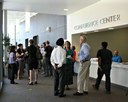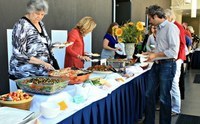Summer Event Highlight: Phenotyping Conference

Nearly one hundred participants attended the phenotyping conference at UC Davis to discuss methods and strategies for incorporating a range of phenotyping measurements into the study of diet and health. Aifric O’Sullivan, a postdoctoral researcher at the Foods for Health Institute and one of the conference organizers, explained that the conference intended to bring together “experts from a range of scientific disciplines with the common goal of phenotyping, to improve not only food and dietary guidelines but also behavior change strategies, and methods to monitor change and promote adherence to health recommendations.” She added, that while both the “WHNRC and UC Davis are well established in this field, this conference marks an important step in the future of personalized health.”
Phenotyping, as a method, offers researchers the ability to measure many markers of health along with the standard details like glucose levels, heart rate, etc. Phenotyping, as a “shotgun approach” to health measurements, can make a difference in the project of personalizing health care. Within food and dietary health, phenotyping measurements can account for markers like age, gender, activity level, and much more detailed markers that are created based on an individual’s responses to food.
The conference began with an introduction by Lindsay Allen, Director of the Western Human Nutrition Research Center, and Bruce German, Director of the Foods for Health Institute, followed by an opening lecture by Ralph de Vere White, Director of the UC Davis Comprehensive Cancer Center. The remainder of the day included presentations from UC Davis and WHNRC researchers on phentyping metabolic health, phenotyping inflammatory health, and imaging-based phenotyping.

The second day of the conference included presentations on phenotyping microbiota from UC Davis faculty members, Jonathon Eisen and Carolyn Slupsky. Two presentations by Dustin Burnett, Principal Dietician at the WHNRC, and Amy Myrdal Miller, Director of Programs and Culinary Nutrition at the Culinary Institute of America, commenced an interactive lunch session where participants were challenged to build their lunch plate incorporating their personal phenotype, Californian (Pacific West) foods, and the USDA MyPlate guidelines.
Myrdal Miller was especially impressed with the lunch menu, and “all the hard work that went into developing a very low sodium menu that allowed attendees to salt their food at the table to meet their sodium preference.” She continues, “sodium reduction is a challenging issue for the restaurant and foodservice industry, but we are making progress by working closely with researchers, food manufacturers, and commodity boards to develop and test culinary techniques and flavor development strategies that help reduce sodium...while still providing great flavor!”

Along with insightful and diverse presentations, conference participants were encouraged to test whether or not they were “supertasters” by allowing the students in the Foods for Health Institute's Undergraduate Mentorship Program to count their papillae, or the tiny structures on the tongue that contain taste-buds.Erin Lockett, one of the mentorship program volunteers, was thrilled to get the chance to help coordinate the conference activities and hear about the exciting research of her professors and mentors.
The conference concluded with a breakout session designed to provide participants structured interaction with industry, academic, policy, and consumer organizations. In these sessions, participants discussed the possible future research priorities in the emergent and exciting field of phenotyping measurements and dietary guidelines.